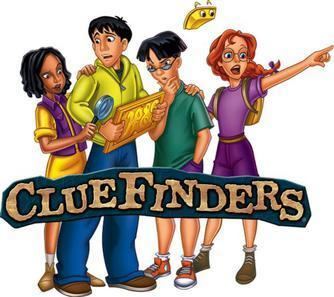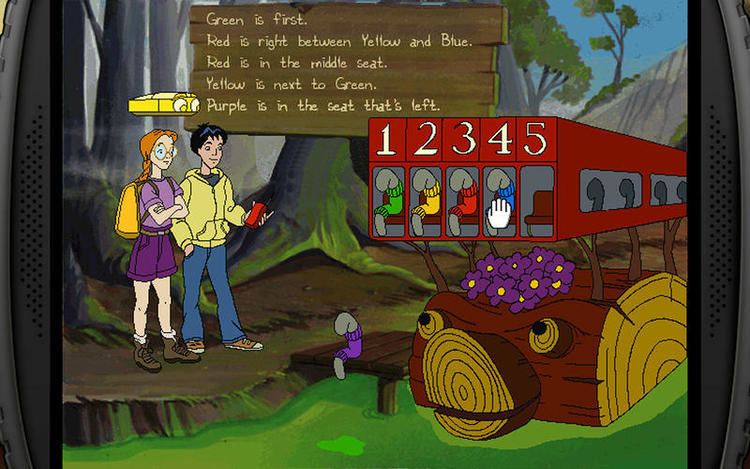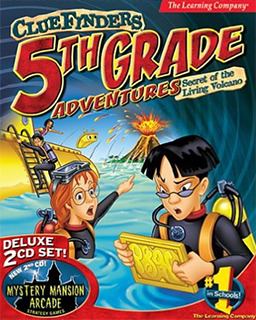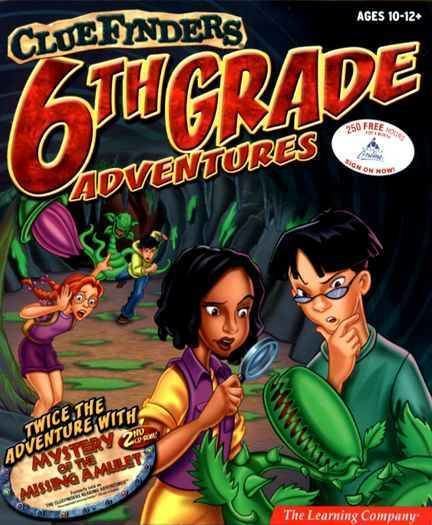Genres Edutainment Publishers The Learning Company | Developers The Learning Company Year of inception January, 1998 | |
 | ||
First release The ClueFinders 3rd Grade Adventures: The Mystery of MathraJanuary, 1998 Latest release The ClueFinders: Mystery Mansion Arcade2002 | ||
Whoa i remember the cluefinders 3rd grade adventures part 1
The ClueFinders (also known as ClueFinders) is a series of educational software aimed at children aged eight to twelve. The series was created by The Learning Company as a counterpart to their Reader Rabbit series for older elementary-aged students, and features a band of mystery-solving teens. The series has received praise for its balance of education and entertainment, and has won numerous awards.
Contents
- Whoa i remember the cluefinders 3rd grade adventures part 1
- The Learning Company era 1997 2001
- RiverdeepHMH era 2001 present
- Plot
- Gameplay
- Graphics
- Educational goals
- Books and fan fiction
- Reception
- Commercial performance
- References

The Learning Company era (1997-2001)

ClueFInders was conceived as a continuation of the Reader Rabbit series, appealing to the older 3rd-6th grade level. The first ClueFinders title was released in 1998 and most of the subsequent games were released within the next two years. In 1998 The Learning Company used Cluefinders' 4th Grade Adventures as the prototype for Internet Applet technology that allowed users to download suppliemtnary activities from the Cluefinders website. Six games were released across 1998-1999, while 2000 and 2001 each saw one new ClueFinders game. These releases were followed by a noneducational bonus discs. Cluefinders held a writing competition in 2001. Sponsored by The Learning Company, the competition was open to 2rd-6th grade classrooms in the United States. The winning essay - a new adventure for the ClueFinders crew, won an iMac. In 1998, The Learning Company was acquired by Mattel for $3.7 billion, considered one of the worst deals in busienss history; the following year Mattel sold off their The Learning Company assets to Gores Technology Group. In the year 2000, Mattel Interactive hired professional writers Jill Gorey and Barbara Herndon had designed a concept for a TV series, however the franchise never made its way to television.
Riverdeep/HMH era (2001-present)

In 2001, Riverdeep acquired many of The Learning Company's properties from Gores Technology Group by selling $40 million in stock. Carmen Sandiego, ClueFinders, and Reader Rabbit were then licensed to the KidsEdge Web site in 2002 where they were available to play among 170 games and activities. The 2004 RCN InterACTION service allowed parents to stream over 35 games in series such as Carmen Sandiego, Clifford the Big Red Dog and ClueFinders over a broadband connection. Bundles including multiple previously released titles, such as Cluefinders Adventure Pack, Cluefinders Triple Pack', and The ClueFinders Math Learning System 2007, have since been created. Around this time, LeapFrog Enterprises created three Browser games, which cast different voice actors. As of 2017, Houghton Mifflin Harcourt (the successor of Riverdeep) is offering the Cluefinders brand as a licensing opportunity on its website.
Plot

Development of the games' "super compelling" and "rich" backstory took 16 months. The ClueFinders' adventures takes place in the contemporary real world incorporating some elements of fantasy and science fiction, with merely the continued presence of LapTrap pushing the series into the realm of science fiction. They simultaneously had a sense of urgency toward an end goal while allowing players to explore and use their minds on puzzles. Nevertheless, the opening titles from The ClueFinders 5th Grade Adventures place the series in the present day. The main cast of "complex" and "flawed" characters include ClueFinders founder and tomboy Joni, skater dude Owen, mechanically-minded Santiago, literary-minded Leslie, artificial intelligent LapTrap, and intellgent dog Socrates. They were chosen to be around the same age as they players after the art director ran various character designs by a group of kids; unsuccessful designs included animals, rock stars, FBI agents, which came across as babysitters instead of teammates. The developers used a character grid to aid their writing; it comtained information such as: "their flaws, their fears, how they met, where they grew up, and their likely reactions to certain situations".
Gameplay

The series consists of "Multisubject by grade" programs, in which players practice skills and advance understanding of grade-based content. The player can choose to play the adventure mode or to play the game's activities outside the adventure in "practice mode." Choosing to play the adventure will lead to a follow-up sequence which further establishes the premise as well as the overall goal of the game. The bulk of each game involves traveling between different screens in a predetermined area which has various educational activities. The user will have to play these games to advance. Most of the time, each area will have one activity that needs to be completed to advance onwards, but which can only be played by collecting items from all the other activities in the area. In all the games except for The ClueFinders 4th Grade Adventures, the ClueFinders are split into two teams at the start. A portable red videophone allows the two teams to make contact with each other and clicking on the phone provides the user with game hints from the other team. The other team will typically either be serving as backup, looking for clues, or else be captured and in need of rescue.
Graphics
During the gameplay, 2D computer graphics are used in the style of hand-drawn animated cartoons with animations that use thick outlines and solid colors on two-dimensional backgrounds. For this reason, the series is often described as imitating the look of a Saturday morning cartoon Scooby-Doo being repeatedly cited by reviewers. Cutscenes however use pre-rendered 3D graphics.
Educational goals
While Reader Rabbit was popular with younger audiences, the Learning Company came up with ClueFinders to appeal to third graders onward for both boys and girls. To coincide with kids' abstract thinking, the games were activity-centered and included cross-curriculum topics more sophisticated than preschool material, which included algebra, grammar and spelling. To ensure that users actually learned something, the educational content came first before the puzzles, game play and objectives. The A.D.A.P.T.Learning Technology was introduced into The ClueFinders titles in 1999,; the system contained a series of customisable features that would facilitate the player's learning by: Assessing abilities, Developing skills, Adjusting levels, Providing help, and Tracking progress.
Books and fan fiction
Two ClueFinders books, The Mystery of Microsneezia and The Mystery of the Backlot Banshee, were written by Ellen Weiss and illustrated by Mel Friedman.
FanFiction.Net currently has exactly sixteen stories featuring the ClueFinders, and a ClueFinders section was added to Games in 2010.
Reception
Teach thought the Search and Solve Adventures mystery was engaging, and that the game successfully combined storytelling with problem-solving activities. Computer Shopper and SuperKids described 3rd Grade Adventures as the educational equivalent of the Indiana Jones trilogy. PC Mag thought Search & Solve Adventures was "mysterious and chill-inducing". Discovery Education wrote that 5th Grade Adventures "seamlessly combines fun and learning". SuperKids praised the "cartoon quality animation and an alluring storyline" of The ClueFinders' Math Ages 9-12, and the Cluedo-inspired gameplay. PC Mag liked The ClueFinders: The Incredible Toy Store Adventure!'s maths, science, and language puzzles, and its adjustable levels.
In 2002, The Boston Herald commented the series had "come a long way", and suggested that the decision to include a Caucasian (Joni), Asian (Owen), Black (Leslie), and Latino (Santiago) in its main cast smelt of interference from the California School Board standard. The paper praised the series' "television-quality animation, broad educational focus and lively situations", though thought the early games were uneven in difficulty. Childrens Software Review managing editor Ellen Wolock criticised The Learning Company for focusing too much of its resources on repackaging its old software, commenting that she received the impression the company was "just throw[ing] together" entries in its newer ClueFinders series.
Commercial performance
By 2001, the first six games had sold around 3.5 million copies.
